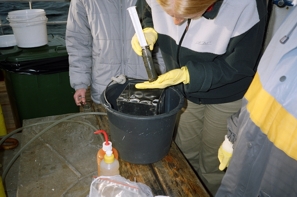 Meiofauna
sampling - large syringes are inserted into box corer sediment
sample Meiofauna
sampling - large syringes are inserted into box corer sediment
sample |
Methodology - Benthos - MEIOFAUNA
Meiofauna in sediments
Meiofauna is
collected from the sediment cores, obtained from a perplex tubes
of 3,6 cm diameter (surface ~10 cm-2 is appropriate
for all types of sediment), inserted 15 cm deep into the seabed.
From one site six (at least three) replicates are taken. Sediment
is gently pushed out from the tube and cut into the slices. Te
slices are usually taken from particular layers: 0-1, 1-2, 2-3,
3-4, 4-5, 5-10 and 10-15 cm. Sometimes core is cut every 1 cm into
even slices. Each sediment slice (subsample) is placed into the
separate
jar, fixed with 4 % neutral formaldehyde solution and stained with
Bengal Rose, to obtain a pink/reddish color of the sample. For
extraction of meiofauna from sediment are used two methods depending
of the
amounts of the detritus or silt-clay in the sediment. Decantation
method - when the sediment is a sand with low amounts of detritus
or silt-clay. In the laboratory, each slice is placed in the 1000
ml cylinder, filled with tap water and shaken vigorously, to suspend
the sediment
grains. The water is then filtered through 0.038 mm screen, and
the procedure of shaking and flotation is repeated 10 times. All
meiofauna
organisms are retained on the screen, are gently washed into the
Petri dish with measuring grid on the bottom and counted under
the low power stereo microscope. Density gradient centrifugation
method - the extraction from mud or detritus is most efficiently
using a density gradient in a centrifugation
procedure (Heip et al. 1985). In this method liquid with a density
larger than the density of meiofaunal organisms can be used (Ludox,
density of 1.15) The method consist: placement of sediment sample
into the Ludox solution, centrifuge it with 1800 g for 10 min.
The meiofauna organisms are
retained in the 'gel', once the sediment is on the end of the tube.
Repeat centrifugation three times more. This method does not work
for heavy foraminifera, since their density is often equal to the
sediment grain. In the lab, the meiofauna organisms are counted
on the measuring grid, usually 1000 specimens per sample (sediment
slice). |